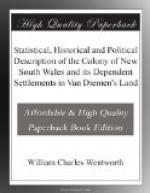This first edition accepts as fact the phantom of that transcontinental stream and expatiates on the blessings which it would bring, patterning its concept of the Heart of the Australian Continent upon what was known of the Great Plains of America, then just being opened up. Any child with an Atlas in hand can now decry the mistake of having given to this concept more credence than did Oxley or Macquarie: does not hindsight make history so simple?
Abandonment of simple optimism on this physical fact must have been quick and uncomfortable: but abandonment of some other precepts must have been slow and more painful. At the time of this first edition, the influence of the Enlightenment was completing its penetration into politics and economics. Man had only to be given freedom, and he would enter into a political Paradise: the forces of the free market had only to be left untrammelled, and they would create of themselves an economic Eden!
These are the enthusiasms of the first edition, where Bligh represents the forces of repression and darkness, while Macquarie and Macarthur are both to be numbered among the angels. By the time of the third edition (1824, nearly contemporary with the author’s return to Australia) the winds of change had blown through the Australian scene. Bigge had presented his Report, which destroyed so much of Macquarie’s work, and the Exclusives, in the author’s view, were leagued with enemies of Australian identity.
For the next thirty years the politics of New South Wales were vigorous and variegated. Nobody who was at their centre could have maintained all his illusions as to the essential goodness of human nature, if only it could be freed from the unnatural chains with which society had bound it. Nor could anyone who participated in the commercial life of those times, who had lived, for example, through the depression of the forties, have preserved untarnished the precepts of Ricardo—published only a few years before 1819, and accepted as gospel in that first edition.
So some of those 1819 enthusiasms had to be abandoned: but the objectives were not. Most of them were eventually to be translated into action and actuality. It was in their modification, perhaps, that the author was to display most of all his foresight and acumen. From 1848 onwards he recognised the true nature of “the spectre which haunted Europe”—and which still haunts the world. From then onwards he was not to write in the way which he wrote here.
W. C. Wentworth
24th February, 1978
* * * * *




